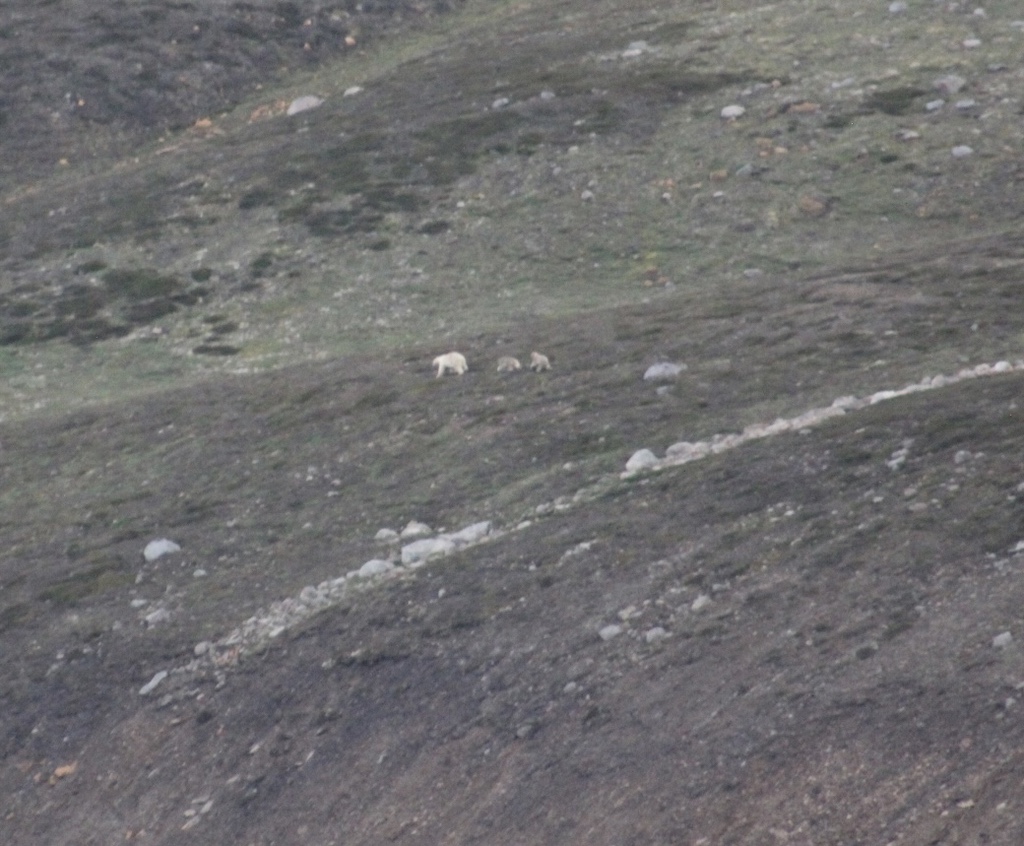What’s your favorite part of this Arctic Expedition?

Scenery so spectacular it looks like art on this A&K Expedition “In Search of the Polar Bear”
By Eileen Ogintz
We still have several days to go on our Abercrombie & Kent Arctic Expedition “In Search of Polar Bears. We already have had so many memorable experiences and a seamless experience (except for the inevitable flight delays some have navigated to get here).
Polar Bears (from a distance). Walruses (lots!). Harp Seals (thousands!). A tiny Greenland village with just 500 people. Lectures from world class experts.
[Photos by Andy Yemma]

“You just expect that these days,” said Lori Latta who had an unexpected overnight in Newark when she and her husband missed their connection to their international flight.
“It’s so nice to just show up and everything is taken care of,” said Nikki Stevens, a Coloradan often tasked with planning trips.
“I feel really lucky to be in this place and have such renowned presenters,” she said. We’ve had lectures from world-renowned experts on Polar Bears, Climate Change, Geology, Birds (The Arctic Tern migrates over 44,000 miles each year from the Arctic to Antarctic, the longest migration of any animal, Ornithologist Dr. Pepper Trail tells us) and Botany (the Arctic Poppy is the most northern growing plant in the world, says Botanist Nellie Nilsen, who grew up in the Arctic in Trondheim, Norway!) The lectures are so inclusive complete with graphs, diagrams, and photos, we feel as if we’ve been invited to a graduate school seminar.

“It is all fantastic,” Nikki Stevens said. “The wildlife, meeting people from all over, the food and even taking a nap in the afternoon,” she joked.
But ask a handful of the 120 well-traveled guests what they like best and most will have a different answer.
“The scenery is so spectacular. The ice looks like art.”
“I’m really enjoying the lectures,” said Linda Turley, an attorney from Dallas.
“I love the adventure,” said John Claypoole, from Manhattan.

And then there is the exquisite service. “When I’m on vacation, I want what I don’t have at home,” said Gwen Scharp, from Lubbock TX.
That includes meals where there is always something innovative (octopus risotto for lunch; fresh Norwegian Halibut for dinner; eggs any way you like them for breakfast, along with plenty of burgers (how about with a squid ink bun), fries, steaks, and more. All this is followed by an excellent array of pastries and cheeses—even Baked Alaska one day at lunch which we learn was originally called a Norwegian Omelet because the French chef who developed the “scientific” desert in 1867 during the Paris Universal Expedition was inspired by the discoveries of heat conductivity by Benjamin Thomas, an American physicist who had emigrated to Bavaria. He had demonstrated the insulating power of beaten egg whites, meaning the meringue was a poor conductor of heat, thus it could be flamed. But the Chef thought Bavaria was in Norway. Fun Fact: in 1876, the desert came to America and was served at Delmonico’s to mark the 10th anniversary of the purchase of Alaska from Russia and called, what else, Baked Alaska.

There is a different tea every afternoon: chocolate, macaroons in an array of flavors, Iberian Ham, Scandinavian treats. As everything is all included on this luxury expedition—even laundry—there is no need to stint on whatever you want. It’s difficult to visualize the hardships those early Polar explorers faced from this vantage point when they had to wrap themselves in fur to keep warm and eat their sled dogs when they ran out of food, noted Rob Caskie, the historian on board.
About 75 per cent of the guests have been to Antarctica and note how different this experience is. “Here the wildlife meshes into the terrain,” Lori Latta said. “This Is a pursuit. In Antarctica, the wildlife are all right there.”
That means we focus more on the scenery. As I write this, icebergs are floating by the windows. We have just left Charcot Havn, a peninsula in Eastern Greenland that is part of the Northeast Greenland National Park Zone that is remote and uninhabited. Yesterday we visited an Inuit village of Ittoqqortoormit, just 500 people, including kids who liked nothing more than tossing a soccer ball into Scoresby Sound or posing for pictures with us. That they didn’t speak much English wasn’t a barrier.
This afternoon we are heading to Vikingeebugt, the largest of a series of small inlets in the fjord system in East Greenland. Hopefully, we will see some whales.

This morning, we were woken before 6 am by our Expedition Leader, Chris Srigley, that there had been a sighting of a Polar Bear on shore. This expedition is entitled “A search for the Polar Bears,” after all.
We all rushed on deck with cameras, long lenses, and binoculars and in the distance, we could see a Mama Bear and two cubs. Earlier in the trip, Morten Jorgensen, our Polar Bear expert, and author of “Polar Bears Beloved & Betrayed” explained that female Polar Bears only mate every four years, typically having two cubs. Half of the newborns will die in their first year.
That there is less sea ice and thus less ability for female bears to find enough food for herself and her cubs “impacts cub mortality and pregnancy,” he said, as does hunting where it is legal by indigenous people, like in Canada.
“There is no doubt that the reality is Polar Bears are being managed it extinction,” Jorgensen said. That makes this sighting all the more special and bittersweet.

